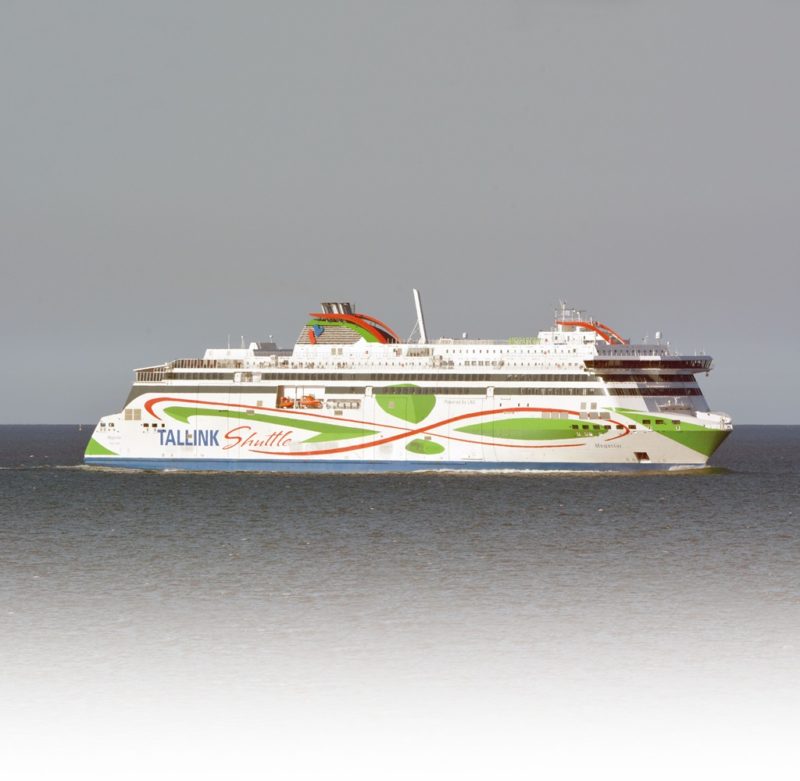
The present Port of Tallinn consists of the Old City Harbour and the Port of Paljassaare with a constant flow of ferries and cruise ships, and the oil, gas, dry bulk and container port of Muuga. Two much smaller ports of Paldiski and Saaremaa, the latter an island in the Gulf of Riga, complete the portfolio of this cluster of ports. The current traffic throughput is around 20 million tonnes per annum, although as recently as 2006 some 41.2 million tonnes throughput was achieved. Trans-shipment cargo makes up 75% of these totals, both of Russian source and of Western European sources, and in both dry cargo shipments as small as 400 tonnes to oil cargoes in giant VLCC tankers of over 300,000 tonnes.
The last thirty years have proven to be very challenging times for Estonia, with savings accumulated in Russian roubles wiped out when the U.S.S.R. encountered massive financial problems in 1991/92 and had collapsed by 1995. A new currency had to be introduced by Prime Minister Mart Laar together with his new and apt phrase of ‘Estonia is the little country that can achieve’. By the Millennium, Estonia was enjoying record growth and increased prosperity, with many public projects begun with EU money and foreign banks giving generous private loans. Estonia entered the Eurozone during 2010/11, and with the currency changed again to the Euro, Estonia has forged ahead. Tallinn has grown into a dynamic and exciting port city during the space of just thirty years. Tallinn is an architectural wonder of a city with stunning examples of modern architecture to restore the newfound confidence of its people.
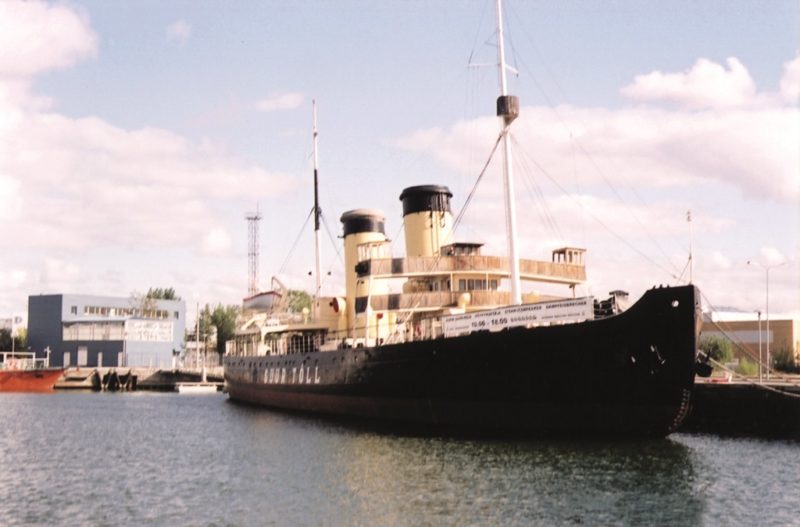
HISTORY OF TALLINN
Tallinn is the capital of Estonia and is a fine old walled city with medieval buildings and towers dating from the 14th century, and also has many fine modern buildings. The first fortress was built in 1050 on Toompea Hill, and a town began to flourish with the Danes capturing the port in 1219. In the one hundred years of Danish rule up to the year 1346, Tallinn had its first name of Taani Linn, meaning ‘Danes Town’. In 1346, the Danish king sold Tallinn to Germany, and it flourished in the 14th and 15th centuries to become a leading member of the Hanseatic League alongside Lubeck and Stockholm and other Baltic ports. By banding together, German merchants achieved unity around the Baltic and created the most dominant trading organisation in the world at that time, with Tallinn having the Teutonic name of Reval. In 1521, the people of Estonia voluntarily offered their land to Sweden, and there followed two happy and prosperous centuries before seizure by Russia.
It was only in 1638 when the overseas mail connection to Sweden began that a scheduled passenger and mail service started. At first mail was carried on the route between Tallinn and Porkkala, Turku, Ahvenamaa (Mariehamn) and Stockholm, but soon also a direct connection between Tallinn and Stockholm. The Tsarist period of rule of Estonia began in 1710 under Peter the Great. The Tallinn to St. Petersburg railway of 1870 increased the fame of Tallinn as a major trading centre with Estonian merchants trading with and sending agricultural cargo to Lubeck, Stockholm and St. Petersburg in large quantities.
The first Estonian constitution of the newly independent State of Estonia of 1919 unfortunately was not practical, with only emergency powers able to make any progress, as the discussions of the various factions became interminable in the Parliament. This situation came to a head in 1930 when the leader of the Farmers Party, Constantin Pats, came to power and declared a State of Emergency and assumed supreme power. The new constitution that he developed was very similar to most Scandinavian States and the other Baltic States of Latvia and Lithuania in that it had a strong co-operative constitution. A First Chamber of Parliament was elected on a normal constituency basis by the people, and a Second Chamber was elected by professional associations, the free trades unions, chambers of commerce, co-operatives and similarly like-minded organisations.
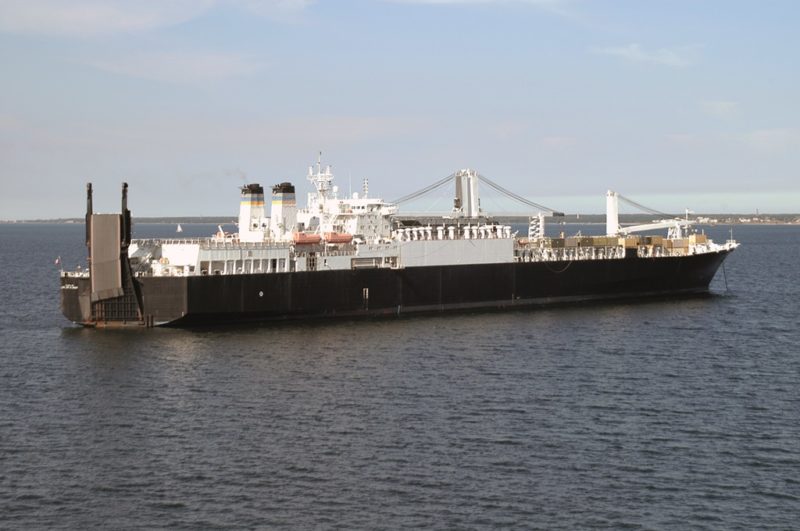
Educational achievements then increased during the 1930s, with secondary and university standards approaching those of Finland. Farming and industry changed from being designed to supply the Russian market to one of supplying the local market and those of other Scandinavian and Baltic States. The area of Estonia is only 18,500 square miles, or half the size of Scotland, and with many lakes and rivers, just as in Finland with its ‘One Thousand Lakes’ tourist banner.
United Baltic Corporation (UBC) of London was founded on 20th May 1919 with a capital of £2 million in £1 shares in equal shareholdings of Andrew Weir & Co. Ltd. of London and the East Asiatic Company (EAC) of Copenhagen. There was no direct shipping connection between the U.K. and Estonia, Latvia, Lithuania and Poland at that time. After the Depression years, when freight rates had returned to normal in 1937, the Anglo-Estonian Steamship Company with offices in Tallinn, the Anglo-Lithuanian Steamship Company with offices in Kaunas, the Anglo-Latvian Steamship Company with offices in Riga and Liepaja, were established as subsidiaries of UBC to help build trades with the Baltic States. These Baltic States finally became independent from Russia between 1991 and 1994 with the last Russian troops withdrawn from Lithuania in August 1994. By 1939, UBC had a fleet of eleven vessels all with a ‘Balt’ prefix to their names trading to the Baltic States, with Baltavia and Baltallinn employed on the Anglo-Estonian Steamship Company service between London and Tallinn with a call at Hull on the return voyage.
Two thirds of the population of Estonia worked the farmland, and half of their produce was carried to London in UBC ships, with British exports to Estonia having doubled during the 1930s.
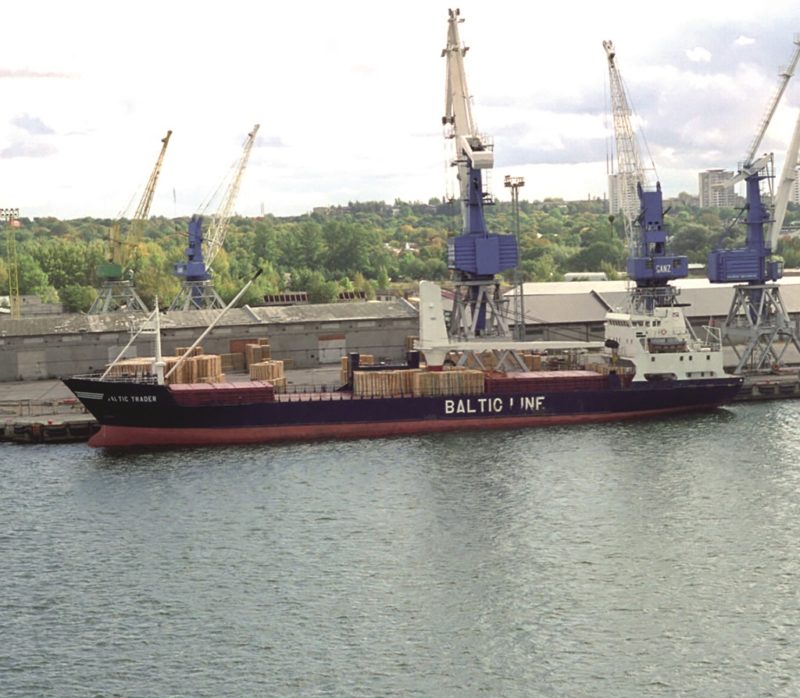
In the summer of 1939, Tallinn with a population of just under one million, was peaceful but rumblings were heard from both of their powerful neighbours of Russia and Germany of demands for military bases. On 22nd August 1939, a German-Russian pact was announced with solemn promises of neutrality for Estonia. As with the agreement made by Neville Chamberlain in 1938 with Nazi Germany, these ‘scraps of paper’ meant nothing and war was inevitable.
On 16th June 1940, Russia seized Estonia, and many Tallinn residents were imprisoned by the Russians for conspiracy and collaboration with Germany. Several prominent citizens of Tallinn were executed including Constantin Pats and others were deported to work in the mines of Siberia. Nazi Germany then entered Estonia in April 1941, and was seen by many Estonians as the lesser of two evils as they were less harshly treated by the Germans than under Russian rule. In September 1944, the advancing Red Army of Russia returned to Estonia, forcing Estonia to become part of the Soviet Union once again, and with Tallinn heavily bombed until the end of the war.
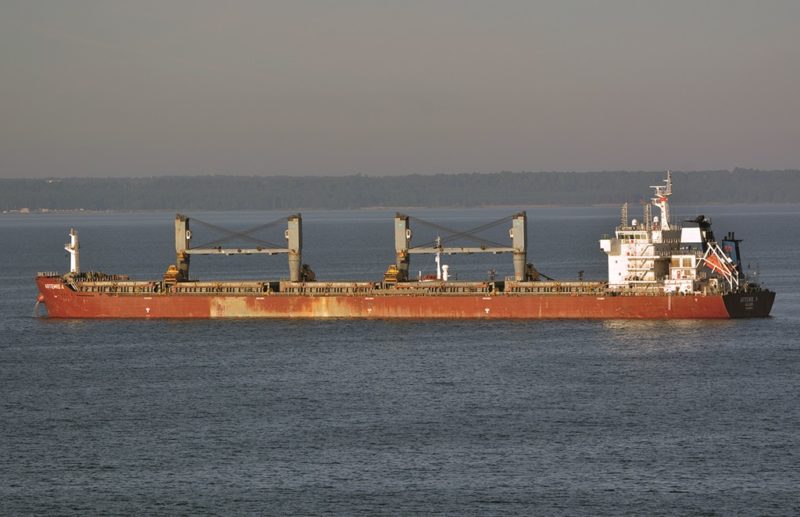
PORT OF TALLINN in POST-WAR YEARS
The Soviet Union dominated Estonia during the post-war years up until Estonia declared its second period of independence in 1991, when the Russian economy began to falter and then collapsed. The Port Authority of Tallinn has developed the harbour infrastructure and administers an ‘umbrella’ management to cover a cluster of five ports, with the Old City Harbour of Tallinn and the Port of Paljassaare having a constant flow of ferries and cruise ships, and the oil, gas, dry bulk and container port of Muuga. Two much smaller ports of Paldiski and Saaremaa, the latter an island in the Gulf of Riga, complete the portfolio of this cluster of ports. The cargo and passenger operations at the Port of Paljassaare, only six kilometres from the centre of Tallinn, have only a limited number of years of operation left as the Port of Tallinn is gradually running down this harbour.
The other ports are as follows:-
OLD CITY HARBOUR
This famous harbour is located very close to the medieval city of Tallinn and covers 54.2 hectares with a total of 22 berths in three basins, Number 1 Basin, Number 2 Basin and Number 3 Basin. The New Mole separates Numbers 2 and 3 Basins, and there is an Admiralty Basin at the head of Number 2 Basin for small Estonian coastal warships. The Bay of Tallinn is occasionally frozen over in severe winters, but with global warming this has usually become a thing of the past. Two new jetties have been built for very large cruise ships and ferries on the western edge of the port to provide berthing for cruise ships up to 1,100 feet in length. In 2023, a provisional list of over 260 cruise ships are due to arrive in Tallinn, while in 2005 there were 324 cruise ship visits and 300 during 2006 and 292 in 2007. The day record of 20th June 2006 saw six cruise ships berthed with a total of 8,067 passengers. Four modern and comfortable passenger terminals for cruise ship and ferry passengers have been constructed.
Regular big Ro-pax ferries link Tallinn with Helsinki, Stockholm, Mariehamn in the Aland Islands and St. Petersburg. Tallink is the main provider of these services and is the largest ferry company on the Baltic after its takeover of Silja Line of Sweden in 2006. Tallink-Silja Line A/S has a dozen big Ro-paxes and two freight ro-ros in its current fleet. Eckero Line, Viking Line and other ferry companies also operate from Old City Harbour. Old City Harbour is a busy, colourful harbour catering for well over nine million cruise and ferry passengers per annum.
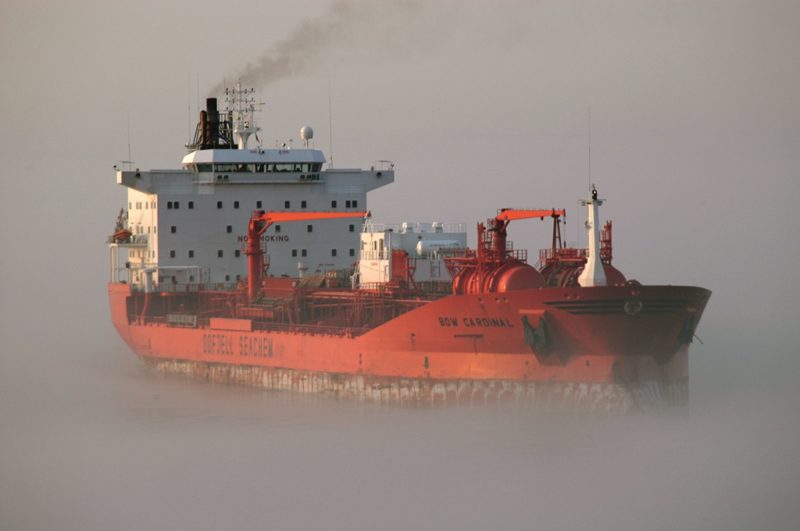
MUUGA HARBOUR
Muuga harbour opened for oil, gas, dry bulk and container business in 1986 and is located 17 kilometres east of Tallinn in the Gulf of Muuga. This deep commercial harbour handles virtually all of the cargo traffic that previously used Old City Harbour as it has alongside depths of 16.0 metres. Container cargo has increased rapidly at the container terminal in the eastern part of the harbour to 1.892 million tonnes in 2021 and half a million TEU of containers handled. There is an extensive container storage yard. Coal is handled at the Coal Terminal in the eastern part of the harbour, while oil, gas and petrochemical products are handled in the western part of the harbour. Grain, fertilisers, steel, and other dry bulk cargoes are also handled at a two quay terminal for dry bulks, a two quay terminal for metals, and with the container terminal yard constantly increased in area.
Muuga harbour covers 524.2 hectares and contains 28 berths of a total 5.9 kilometres in length. It can accommodate vessels up to 300 metres in length and 48 metres in width and has six terminals for liquid bulk cargoes, two multi-purpose terminals, as well as a container terminal with extensive rail lines to the national rail network. There is a reefer container depot of 11,500 m2 in area, plus in the remainder of the port 151,000 m2 of warehouse space, 670,000 m2 of open storage, 1.1 million m3 of oil storage, and storage for 300,000 tonnes of grain. There are over one hundred large oil and gas storage tanks in this port, whose size and the importance of Muuga harbour to the economy of Estonia cannot be overstated.
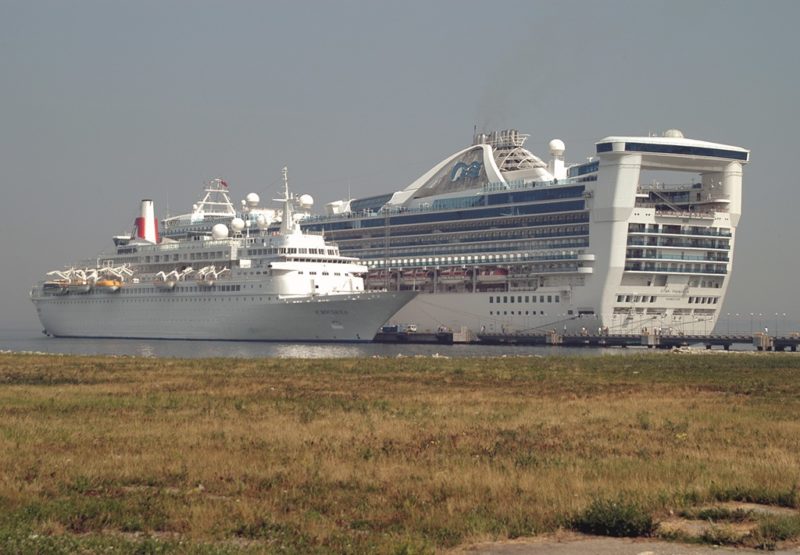
PALDISKI HARBOUR
Paldiski Harbour is located 45 kilometres to the west of Old City Harbour and serves passenger ferries, ro-ro cargoes, exports of local products, and transhipment of liquid bulk and metals cargoes. The ferry route to Kapellskar in Sweden, located 90 kilometres north east of Stockholm, and other Swedish ports is shorter than that of Old City Harbour, and thus the regular ferry timetable is quicker by five hours. A huge investment has been made in the infrastructure and eight berths of the port clustered around an open harbour, as well as railway connections and new roads. The harbour covers 114.7 hectares with a quay length of 1.4 kilometres and alongside depths of up to 13.5 metres. Vessels up to 230 metres in length and 35 metres in the beam can be accommodated with ro-ro cargo, timber, metals, biodiesel and automobiles and truck imports as the main traffic. There are 12,000 m2 of warehouse area, 270,000m2 of open storage and an oil tank storage capacity of 260,000 m3. The berth total of the harbour will be increased in the future, and the expansion of this smaller port will be ongoing.
SAAREMA HARBOUR
The smallest of the four ports in the Port of Tallinn cluster of ports is located on the north coast of the island of Saarema in the Gulf of Riga. The other large island of Hiiumaa is to the north of Saarema but also in the Gulf of Riga. There are two cruise ship berths on an ‘L’ shaped jetty, a quay for auxiliary vessels, and a floating berth for small craft. Vessels up to 200 metres in length can be accommodated including most of the latest cruise ships but not the ‘mega cruisers’ of up to 1,100 feet in length. Construction of this harbour began in the summer of 2005 and was completed ten months later at a cost of €8.6 million. Seven cruise ships visited in its first year of operation in 2006/07. The Port of Tallinn has a ferry subsidiary that offers regular small ferry links from the mainland to the islands of Saarema and Hiiumaa in five small ferries owned by TS Laevad.
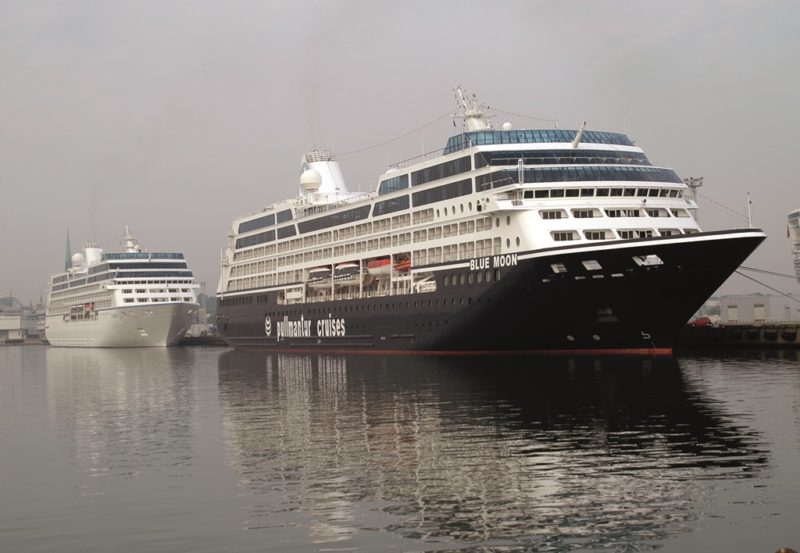
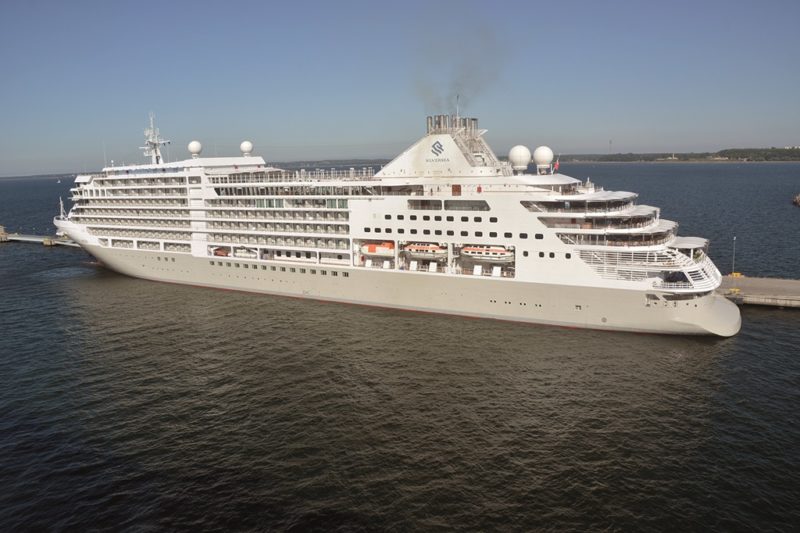
PORT OF TALLINN STATISTICS (2022)
- Cruise and Ferry passenger total – 10.639 million in 2019
- Longest quay for cruise ships – Berth 26/27 at Old City Harbour (421 metres)
- Longest bulker to visit Muuga – La Prudencia of 158,475 gt, 343.71m length
- Largest VLCC tanker to visit Muuga – Maersk Hakone of 302,650 dwt
- Longest cruise ship to visit – MSC Fantasia of 137,936 gt, 333.3 metres in length
- Largest container ship to visit – Celina Star 3,430 TEU, 243.1 metres length
- Longest cargo berth at Muuga – Berth 9a/10a of 340.0 metres in length
The cargo breakdown into sectors in millions of tonnes is as follows:-
2018 2019 2020 2021
Container cargo 1.879 1.835 1.808 1.892
Dry Bulk 3.912 4.514 4.416 4.690
General cargo 0.640 0.595 0.410 0.485
Oil & Products 8.822 7.618 9.088 8.694
Ro-Ro 5.345 5.365 5.563 6.489

TOTALS 20.598 19.927 21.285 22.250
CRUISE LINES CALLING IN 2023
- Aida Cruises 50
- NCL Cruises 24
- RCI 21
- Costa Cruises 21
- TUI Cruises 18
- Princess Cruises 15
- MSC Cruises 15
- P&O. Cruises 9
- Silversea Cruises 9
- Viking Ocean Cruises 9
- Celebrity Cruises 8
- Fred. Olsen Cruises 7
- Seaborn Cruises 7
- Windstar Cruises 6
- Regent Seven Seas Cruises 6
- Oceania Cruises 6
- Holland America Line 5
- Saga Cruises 5
- Phoenix Seereisen 4
- Carnival Cruises 4
- Hapag-Lloyd Cruises 4
- Azamara Cruises 4
- Cunard Line 1
- Ambassador Cruises 1
- Noble Caledonia Cruises 1
- FT Touristik Cruises 1
GRAND TOTAL 262
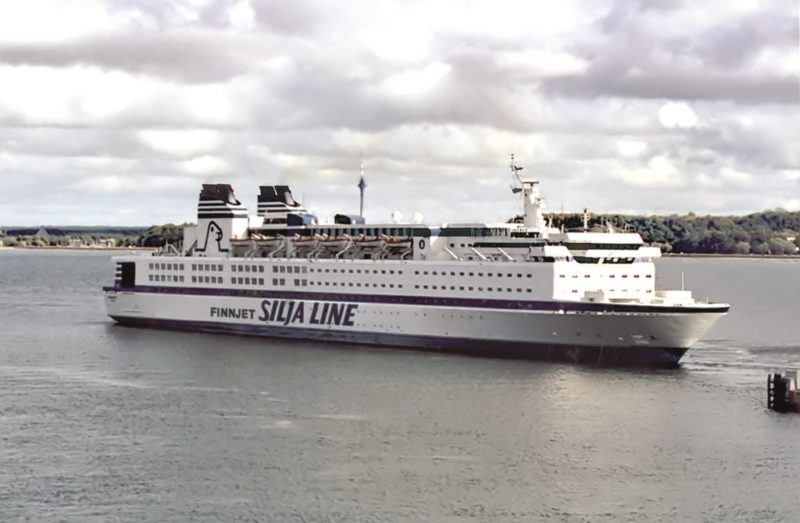
PORT OF TALLINN FERRY COMPANIES
TALLINN-SILJA LINE A/S
The linkspans of the Port of Tallinn handle the big passenger and vehicle ferries of Tallink-Silja Line A/S e.g. Silja Symphony of 58,377 gt and built in 1991 with a passenger capacity of 2,852 and a service speed of 23 knots from four Wartsila Vasa diesel engines on her route between Tallinn and Stockholm in Sweden using ro-ro ramps and double height vehicle loading ramps. The publicly traded company is the largest ferry company on the Baltic, with a net income of E49.7 million in 2019 with 7,270 employees in that year. It can be traced back to 1965 when the Soviet Union-based Estonian Shipping Company (ESCO) introduced passenger ferry services between Helsinki and Tallinn on the ferry Vanemuine. Regular year-round passenger and ro-ro services began in 1968 with the ferry Tallinn, which served the route until she was replaced with the new ferry Georg Ots of 12,549 grt in 1980.
Tallink was formed in May 1989 as a subsidiary of ESCO in a joint venture with Palkkiyhtyma O/Y of Finland and purchased the ferry Scandinavian Sky from SeaEscape at the end of that year. She entered the Tallinn to Helsinki route under the name of Tallink on 8th January 1990. The freight ro-ro Transestonia joined Tallink on the same route later in 1990. In the early 1990s, passenger numbers were steadily increasing on the Tallinn to Helsinki route, and during the winters between 1992 and 1995 the chartered Saint Patrick II arrived from Irish Ferries to cope with demand.
Tallink became a wholly owned Estonian ferry company in 1993 when the Finnish joint partner sold its shares and the ferry Tallink to ESCO of Russia. The ferry Vana Tallinn joined the fleet in 1994 together with two fast hydrofoils, HS Liisa and HS Laura. The chartered ferries Balanga Queen and Ambassador II were placed on the Helsinki to Tallinn and Travemunde in Germany route at the end of 1994. The much larger ferry Melodia of 17,965 grt and built in 1980 with a service speed of 19 knots was chartered from Estline, having been built as Mare Balticum. A second large ferry in 1997 was the chartered Normandy of 24,872 grt, built in 1982, from Stena Line. In December 1997, Tallink purchased the ferry Lion King from Stena Line to replace Normandy from the end of her charter.
In 1999, ten years after its formation, Tallink was operating six conventional ferries as well as the fast ferries Tallink Express and Tallink AutoExpress, which had replaced the hydrofoils. The fleet comprised Fantasia (ex Lion King), Melodia (ex Mare Balticum), Tallink (ex Scandinavian Sky), Vana Tallinn (ex Thor Heyerdahl), George Ots and the freight ro-ro Kapella for the faster route from Paldiski to Kappelskar in Sweden.
The important passenger route between Tallinn and Stockholm began to be marketed by Tallink in Millennium year, with two chartered Ro-paxes chartered from Est Line in Regina Baltica and Baltic Kristina. In the three years between 2001 and 2004, three more fast craft named Tallink AutoExpress 2, Tallink AutoExpress 3 and Tallink AutoExpress 4 joined the fleet. The larger sister Ro-paxes Romantika and Victoria I of 40,975 gt joined the service in 2002/03 between Tallink to Helsinki and Tallinn to Stockholm respectively, with Fantasia moved to a new service from Helsinki to Tallinn and St. Petersburg in Russia.
The first of four twin-screw Tallink super-sized Ro-pax sisters joined the fleet in 2006 as Galaxy of 48,915 gt to replace Romantika on the Tallinn to Helsinki route. The ‘Galaxy’ class would eventually number four with the same hull dimensions of overall length of 212.2 metres, moulded beam of 29.0 metres, and moulded depth of 15.4 metres by 2017. The ‘Galaxy’ class are essentially lengthened versions of the earlier Romantika and Victoria I. The other members of the ‘Galaxy’ class are Baltic Princess (2008), Baltic Queen (2009) and Megastar (2017), the latter burning LNG fuel and having four uprated Wartsila diesel engines of 45,600 kilowatts to give a service speed of 27 knots, three knots faster than her earlier sisters. The ‘Galaxy’ class carry 2,800 passengers and 420 cars on their car decks of lane length 3,650 metres, with a large shopping area of up to 2,800 m2 to keep passengers happy on their Baltic voyages.
In 2011, the Tallink fleet numbered ten large Ro-paxes after much expansion had taken place in 2006 by the purchase of both Superfast Ferries from the Attica Group of Greece, and the rival Finnish passenger line Silja A/B from Sea Containers. The combined cost of these two purchases was a record €780 million, with Tallink gaining three Superfast Ro-paxes in Superfast VII, Superfast VIII and Superfast IX, the latter chartered out as Atlantic Vision to Marine Atlantic of Canada until 2024. The fleet in 2011 was thus a dozen Ro-paxes and two ro-ro freight vessels:-
- Galaxy of 48,915 gt
- Baltic Queen of 48,915 gt
- Baltic Princess of 48,915 gt
- Star of 36,250 gt
- Superstar of 36,277 gt
- Victoria I of 40,975 gt
- Romantika of 40,975 gt
- Superfast VII of 30,285 gt
- Superfast VIII of 30,285 gt
- Atlantic Vision of 30,285 gt
- Silja Festival of 34,414 gt
- Regina Baltica of 18,345 gt
- Regal Star freight ro-ro of 15,412 gt
- Kapella freight ro-ro of 2,794 gt
However, in August 2011, Superfast VII and Superfast VIII were chartered for four years to Stena Line, with also extensions to the charters, for the new Stena Line terminal that began operating two months later from Cairnryan to Belfast in competition to the existing P & O. service from Cairnryan to Larne. The ferry port of Stranraer was then closed and all traffic was relocated to Cairnryan near the entrance to Loch Ryan.
Tallink currently has multiple daily services from Tallinn to Helsinki, Stockholm and Rostock in Germany, and on average 10,000 voyages are made annually carrying around 9.75 million passengers, 1.25 million vehicles, and almost 400,000 freight units. By the end of 2022, the big Tallink-Silja Line A/S fleet comprised fifteen vessels:-
- Galaxy of 48,915 gt
- Baltic Queen of 48,915 gt
- Baltic Princess of 48,915 gt
- MyStar of 50,629 gt
- Superstar of 36,277 gt
- Victoria I of 40,975 gt
- Romantika of 40,975 gt
- Silja Symphony of 58,377 gt
- Silja Serenade of 58,376 gt
- Silja Europa of 59,912 gt
- Atlantic Vision of 30,285 gt
- Megastar of 48,915 gt
- Isabelle of 35,134 gt
- Regal Star freight ro-ro of 15,412 gt
- Sailor freight ro-ro of 20,921 gt
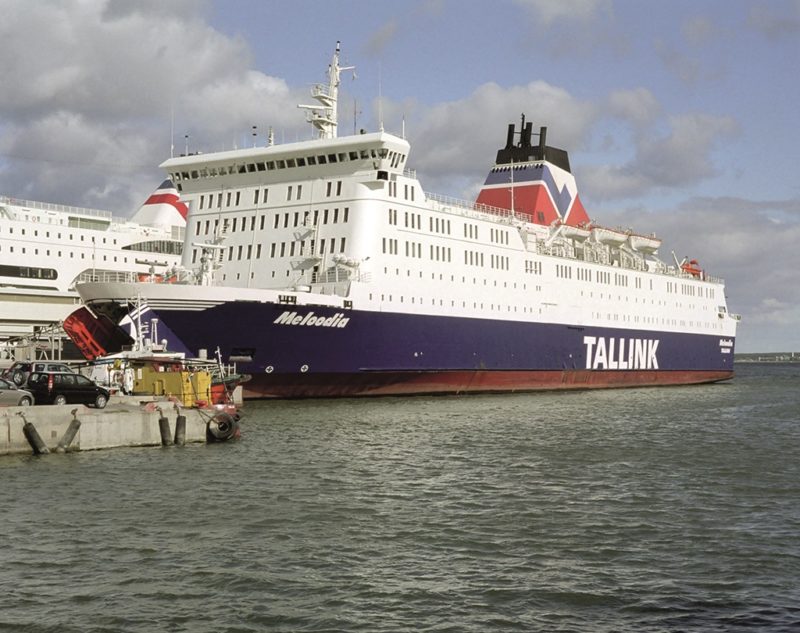
VIKING LINE
The original Viking Line of Mariehamn in the Aland Islands was set up in 1959, jointly by Gunnar Eklund and Henning Rundberg, both Finnish Master Mariners that had previously served together on the famous four masted barque Pamir.
The Southampton to Channel Islands twin screw ferry Dinard of 2,291 grt, dating from 1924, and powered by four steam turbines when completed by the Denny yard at Dumbarton, was purchased in 1959 for £30,000 and sent to Aalborg for conversion into a car ferry. She was fitted with a stern ramp and painted with a light blue hull and two yellow funnels with black tops, and was renamed Viking with Henning Rundberg as manager. In June 1959, she began her daily summer route from Kapellskar in Sweden to Mariehamn and Parainen in Finland, with a twice daily service on Sundays from Kapellskar to Mariehamn.
Kapellskar is a tiny hamlet forty miles north east from Stockholm, whose sole raison d’etre for existence is the now large Viking Line ferry terminal, with a free connecting bus service from Kapellskar into the centre of Stockholm. Ferries have to reverse out of a narrow inlet when leaving for Finland, and a poignant memorial was later placed on a hillside above Kapellskar to commemorate the 852 lives that were lost in January 1994 in the dreadful Estonia ferry disaster in the middle of the Baltic. Estonia was completed at Papenburg in 1980 as Viking Sally of 15,566 grt for Viking Line, and had sailed from Tallinn on her last fateful voyage to Stockholm with five hundred returning Swedish shoppers and three hundred passengers of Estonian nationality, but a severe storm forced open her bow shield and only a handful of strong swimmers survived the freezing winter Baltic waves.
Mariehamn is a charming little town and home to Viking Line, reached by a two hour voyage from Kapellskar. The voyage time is three hours from Mariehamn to Naantali, which is also a small town with a connecting bus service to the larger city of Turku in Finland. It is very worthwhile staying overnight in Mariehamn and then continuing the next day to Naantali. Mariehamn was founded in 1861 by Tsar Alexander II as his summer retreat and was named after his wife Maria. Scenic roads and beautiful countryside take one to Badhausberget with panoramic views over the whole archipelago.
A disagreement had arisen by 1962 between the Viking Line partners Gunnar Eklund and Henning Rundberg as to the way forward. Henning Rundberg preferred tramp and tanker shipping to the new car ferry business, as he already owned the former Klaveness tramp Castleville of 9,000 dwt and built by the Framnaes yard at Sandefjord in 1945, as well as the tanker Linden of 15,680 dwt built by the Scott’s yard at Greenock in 1951 as Linde. Gunnar Eklund then formed another ferry company, Alandsfarjan A/B, and purchased another elderly Channel Islands ferry, this time it was Brittany of 1,445 grt built by the Denny yard in 1933 for the Jersey to France service. She was purchased on 21st April 1963 and converted with a stern ramp and a new large saloon under the bridge across the width of the vessel for passengers from Mariehamn to Graddo near Turku in Finland and from Mariehamn to Herrang in Sweden. She was renamed Alandsfarjan and began her service on 20th June 1963 from Mariehamn to Graddo.
Steam turbine powered British passenger ferries such as Dinard and Brittany used shore cranes to lift a few cars on and off during the 1950s, and were of a simple design compared to the huge Viking Line Ro-paxes of today. Dinard and Britanny had three decks, comprising the Promenade Deck with the First Class Lounge extending fore and aft and the mail room and baggage room aft, Main Deck had the First Class cabins and restaurant forward, with Second Class Lounge and the crew accommodated aft, while Lower Deck had the Second Class Saloons aft for their accommodation, with separate saloons for ladies and gentlemen. They usually had good service speeds of between fifteen and eighteen knots for their Channel services.
In 1966, Viking Line was reorganised as a marketing company by Aland shipowner Stig Lundquist for three ferry operators of Rederi A/B Sally (Algo Johansson), Rederi A/B Slite (Carl Bertil Myrsten) and S-F Line (Gunnar Eklund). The ‘old’ Viking Line was renamed Rederi A/B Sally, and Alandsfarjan A/B was renamed S-F Line, with Rederi A/B Slite also dating from 1959. The joint timetables and tickets were issued for these three separate companies of the consortium, and it was so successful that Viking Line had ordered six of the nine Papenburg sister ferries for delivery between 1970 and 1974 as Apollo, Viking 1, Viking 3, Diana, Viking 4 and Viking 5.
In 1973, Viking Line began service on the Turku to Mariehamn to Stockholm route, competing directly with Silja Line for the first time. During the following year, Rederi A/B Sally began Viking Line traffic between Helsinki and Stockholm, and this route stayed in their hands for the next decade, whereas on other routes the three companies operated together. Rederi A/B Sally was clearly the dominant partner in the consortium by the latter half of the 1970s, and in 1980 took delivery of three new ferries in Viking Saga, Viking Sally and Viking Song of around 14,000 gt. This trio further established their dominance over the other partners, although S-F Line did take delivery of the new ferries Turella and Rosella during 1979/80, and Rederi A/B Slite the ferry Diana II of 11,671 grt in 1979.
In 1985, a new page was turned in Viking Line history when the new large cruise ferry Mariella owned by S-F Line replaced Viking Song on the Helsinki to Stockholm route, thus breaking the monopoly of Rederi A/B Sally on the route. Rederi A/B Slite took delivery took delivery of the ferry Olympia, sister of Mariella, in 1986 and thus forced Rederi A/B Sally completely out of Helsinki to Stockholm traffic. Rederi A/B Sally ended the year with an extremely poor financial position, and in 1987 was purchased by Silja Line. As a result, S-F Line and Rederi A/B Slite forced Rederi A/B Sally to leave the Viking Line consortium.
S-F Line took delivery of three new large Ro-paxes in Amorella, Isabella and Cinderella between 1988 and 1990, with their Mariella and Amorella two of the longest serving Baltic ferries when they were sold in 2021/22 to Corsica Ferries to become Mega Regina and Mega Victoria. Isabella was sold in 2013 to their rival Tallink-Silja Line and renamed Isabelle. Cinderella of 46,398 gt is still operating for Viking Line today as Viking Cinderella. Rederi A/B Slite took delivery of two new large Ro-paxes Athena and Kalypso in 1989/90 from Wartsila Marine yard, which went into bankruptcy during their building, increasing the cost of one of their sister ferries, Despite this problem, Viking Line in 1990 owned the largest and newest cruise ferry fleet in the world with ten large Baltic ferries.
Rederi A/B Slite filed for bankruptcy in 1993 after a devaluation of the Swedish krona forced a huge escalation in the cost of a new cruise ferry, which was sold off to Silja Line. Thus, S-F Line was the sole remaining partner under the Viking Line brand, and changed its name in 1995 to Viking Line.
The new Viking Line owner then operated a fast ferry service between Tallinn and Helsinki using chartered catamarans in summer. The large cruise ferry Silja Scandinavia was purchased in 1997 and renamed Gabriella for the Helsinki to Stockholm route. The Viking Line fleet in 1998 numbered seven ferries in Gabriella of 35,492 gt, Amorella of 34,384 gt, Cinderella of 46,398 gt, Isabella of 34,386 gt, Mariella of 37,799 gt, Rosella of 16,789 gt and Alandsfarjan (2) of 6,336 gt.
Viking Line today operate five large ferries of up to 65,000 gt on the same network as their former sextet of Papenburg built sisters operated in the 1970s. The ferries are Gabriella of 35,492 gt built in 1992, Viking Cinderella of 46,398 gt built in 1989, Viking XPRS of 35,918 gt built in 2008 by Aker Finnyards, Viking Grace of 57,565 gt completed in 2013, and the new flagship Viking Glory of 65,211 gt, which entered service in 2022. Viking Grace and Viking Glory are both powered by LNG gas, and are a far cry from the Papenburg built sisters of the 1970s.
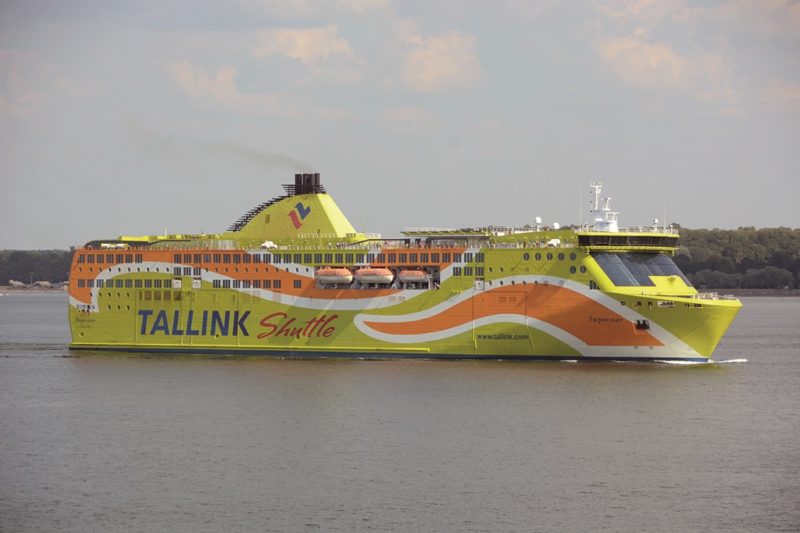
ECKERO LINE
In 1992, Rederi A/B Eckero and Birka Line of Finland founded a jointly owned shipping company Eestin Linjat to operate the ferry Alandia of 6,754 gt on the fast growing route between Tallinn and Helsinki. The company changed its name in 1995 to Eckero Line to avoid any confusion with the owners of the ill-fated ferry Estonia, Est Line, as ‘Eesti’ is Estonian for Estonia. A sister ship of Alandia, Apollo of 6,480 gt, was added to the route in 1995, and in 1998 the ferry Norlandia of 14,990 gt replaced both of these on the Tallinn to Helsinki route. A separate service was operated between Grisslehamn in Sweden and Berghamn in the Aland Islands by Eckero Linjen with Ro-pax Nord Gotlandia (ex Olau Hollandia) of 21,473 gt and freight ferry Roslagen of 6,652 gt, and part of the same financial ownership as Eckero Line.
In May 2004, Eckero Line acquired the ferry Translandia of 13,867 gt as a second ship for the Helsinki to Tallinn route, and she continued to be fully loaded in response to the high demand for freight capacity after Estonia joined the European Union in 2010/11. In 2012, the large Ro-pax Finlandia of 36,365 gt and built in 2001 began to operate on this route, and she operates today along with the freight ferry Finbo Cargo of 21,152 gt, built in 2001 as Midnight Merchant for the Cenargo subsidiary of Merchant Ferries, and from 2011 as European Endeavour for the P. & O. Ferries route between Dublin and Liverpool, and was purchased in May 2019 by Eckero Line.
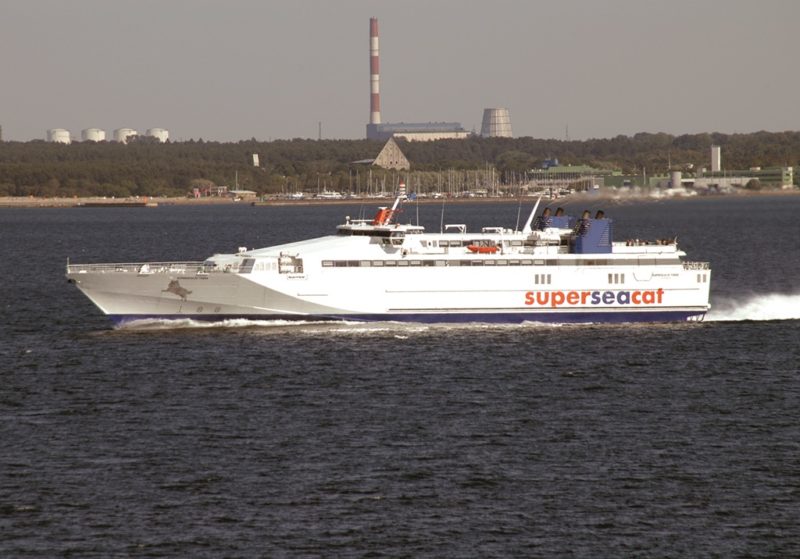
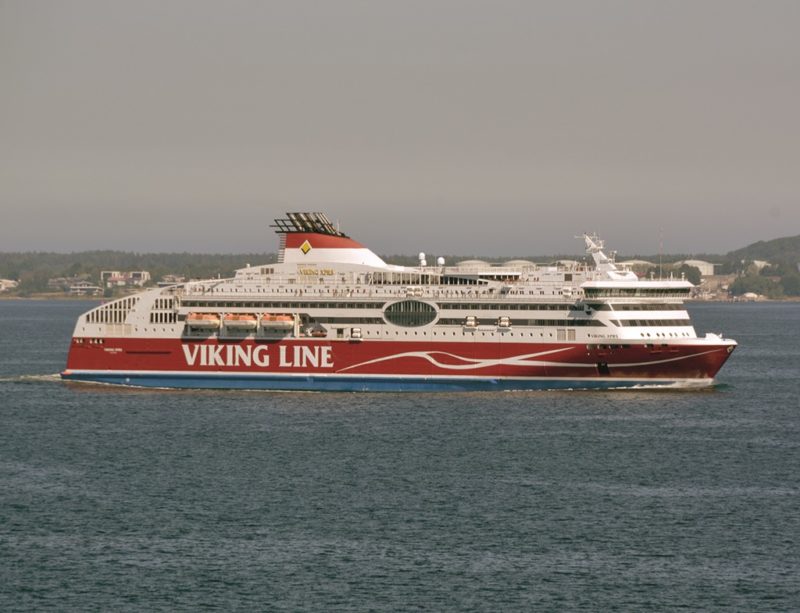
SUMMARY
The Port of Tallinn financial results have seen a big growth in recent years in ferry and cruise passengers, container, dry bulk, general cargo, oil, gas and petrochemicals, and ro-ro traffic. The hinterland of Tallinn has agricultural, manufacturing, tourism, retail, fast transport links, and real estate sectors, as well as excellent IT and communications. The important International Estonian Song and Dance Festival is held in the summer month of July every five years in the Kalevi Keskstadion in Tallinn. Worldwide tourists arrive for the festival that is organised by the Estonian Song and Dance Celebration Foundation.
Future development plans of the Port of Tallinn for Muuga harbour will see a new LNG bunker terminal at Quay 33 constructed by Liwathon E.O.S. in the eastern part of the harbour, along with a food production plant and expanded ro-ro logistics facilities. The Muuga rail network can handle both the Russian and European rail gauges of 1.52 metres and 1.435 metres respectively. Paldiski harbour will expand to handle wind turbine parts, project cargo and oversize and ‘out of gauge’ plant, a new woodchip production plant, and an enlarged Industrial Park of 34 hectares.
Tallinn Shipyard repairs ships alongside up to a depth of 7.5 metres and in three floating docks, including ferries, cruise ships, reefers, ro-ro vessels, LPG carriers, oil tankers, product tankers, chemical tankers, fish factories, trawlers and the Estonian Government icebreakers, lighthouse tenders and research vessels. The City of Tallinn is a ‘gem’ of a destination of great interest for international tourists, and the Port of Tallinn has risen to the challenge of COVID-19 and other problems to look forward to a very prosperous future. The Port of Tallinn Group has 500 employees, of which 300 work in the five port cluster.

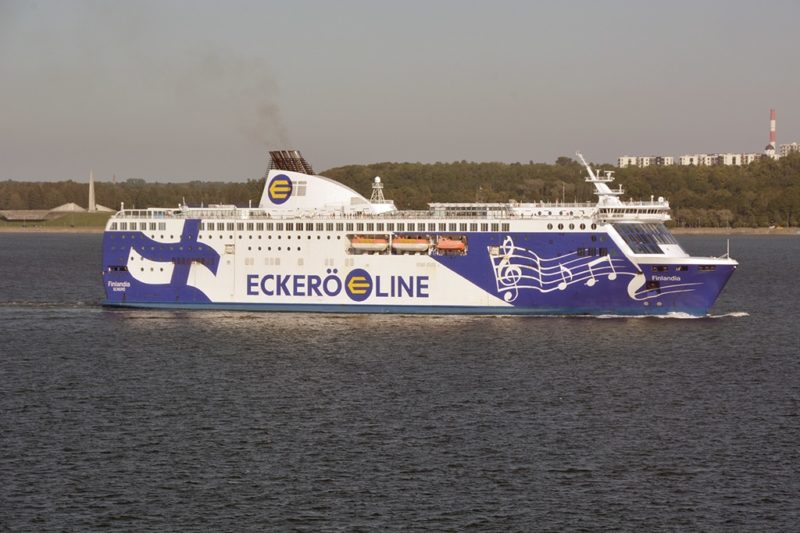
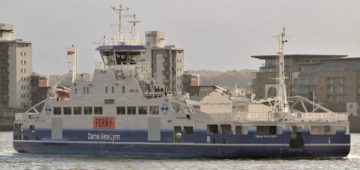



Comments
Sorry, comments are closed for this item